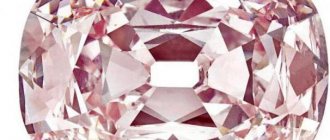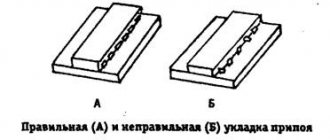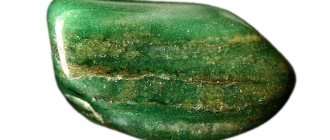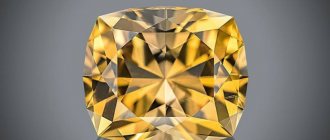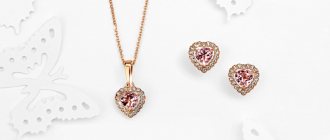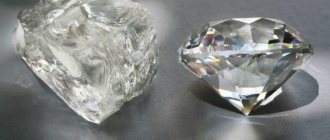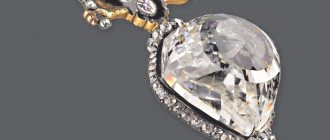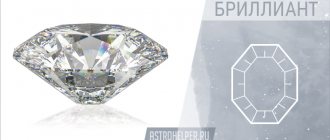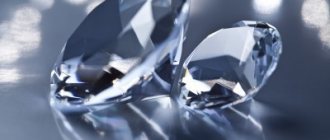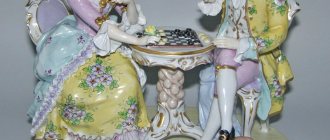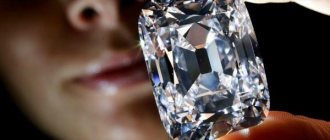Diamond cutting is not only a complex process of polishing jewelry diamonds and giving them a certain shape.
This is one of the main characteristics, including stone parameters, proportions, location and symmetry of edges, and polishing quality.
After all, by nature, a diamond is endowed with only inner beauty, and skillful processing reveals it.
Thus, thanks to the skill and creativity of the jeweler, a diamond is born from an inconspicuous-looking mineral - a stone with an amazing shape and unique shine.
Diamond cutting process: tasks and quality
Diamond cutting photo
Diamond cutting is painstaking work. The master’s task is not only to process the mineral with high quality, but also to find a compromise between this quality and the loss of raw materials for each future diamond.
It is not enough to give the intended shape and maintain the proportions; you also need to preserve the dimensions of the stone as much as possible. This depends on the experience of the cutter and the technologies that modern diamond cutting uses.
The jewelry world has its own unofficial approaches to assessing the quality of this process. For example, many professionals distinguish between such concepts as “Russian” diamond cutting and “commercial”.
In the American market, “Russian” processing was opposed to “commercial”, i.e. having worse quality. It had an effect on the good school of excellence that developed at, and there were 7 of them in the country. Some, for example, the Smolensk plant, are still considered the largest enterprise in the world cutting industry.
Russian diamond cutting became famous due to its high requirements: in 1977, the rules for diamond processing were tightened and strict technical conditions came into force. Over time, the expression Russian Cut appeared in the global market community. Suppliers of stones with this characteristic received up to 10% bonuses.
Many dealers rushed to position their stones as Russian Cut. In fact, their jewelry product had nothing to do with Russia. American expert gemologist R. Sherwood spoke about this as follows: “Russian cut” in a general sense means very high quality.
Although it is correct to use this term for stones cut exclusively in Russia; part of the trade uses it for diamonds from other world regions...” Also, the superiority of Russian crystals over Belgian and Israeli stones was previously noted.
Of course, the industrial transformations of recent decades have had an impact in this area. Globalization is taking place, technology and specialists are being exchanged, and diamond cutting is gradually losing its “nationality.” Today, in the Russian system, according to the quality criteria of processing, a diamond can be classified as class from “A” to “G”.
If the diamond cut does not correspond to any of these groups - A, B, C, D, then the gem is not subject to evaluation according to the specifications. But, as another mineralogy expert put it, “buy the diamond, not where it comes from.” After all, the quality of a cut is best reflected by its color and brightness.
Advantages
Cushion is a cut form that has several variations. They differ from each other in shape, size, as well as the degree of brilliance and “play” inside the stone. The cut can be of almost any shape between square and rectangle, which makes each piece unique.
The Cushion diamond has an ancient charm and charm. Any piece of jewelry with such a stone looks like a family heirloom, passed down from generation to generation. Not every cut shape can boast of this unusual property.
Today, the pillow cut is the most popular among all cuts. Suggesting the romance of a candlelit room, this shape captures light and radiates it with artful beauty, sometimes emitting more fire than even a round diamond. Even in harsh direct lighting, the pillow's shape captures the light and refracts it with romantic warmth.
Types of diamond cuts
As you know, uncut diamonds cannot be called brilliants.
Only in the process of processing according to a certain type are luxurious crystals born.
The types themselves (types of diamond cuts) are as follows:
- Faceted. It includes, in turn, such types of cutting types as diamond, honeycomb, wedge grinding, and step. All these types involve turning the edges.
- Cabochon is the oldest type, characterized by a rounded crystal shape. Currently practically not applicable to diamonds.
- Mixed. Combines features of the first two types.
Until the 20th century, old cut diamonds, such as “rose,” were fashionable.
But it has lost popularity, giving way to a more modern type of facade treatment - diamond.
Flaws
When choosing a cushion cut diamond, you should carefully consider the girdle. It often happens that its width varies: it is wider at the corners than between them. This area is especially vulnerable to chipping. If the girdle is too thin, the stone needs a closed (blind) setting, otherwise it will be regularly damaged.
It is advisable to evaluate cushion-cut diamonds in person before purchasing because the ratio of length to width of the stone may vary. As a rule, they exhibit worse light play than round-cut diamonds. They give a less bright, although beautiful shine in their own way.
Diamond structure
The types and shapes of diamond cuts determine the structure of the crystal. All processed diamonds have a clear structure.
Regardless of the shape that the diamond cut gives them, a properly designed diamond must consist of the following parts:
- “Crown” is the top of the stone. It is also divided into main elements: a platform (a flat surface to which the edges adjoin), the main edges of the top, single wedges of the top (star facets), a number of paired wedges of the top.
- “Girdle” is a strip separating the crown and the lower part. A diamond cutter can be considered a high professional if he managed to make the girdle minimal in width. In addition to the separating function, this element performs a protective mission (from chipping) and an aesthetic one - the improvised line thins out the light with which the edges play beautifully.
- “Pavilion” is the lower pointed spike. Its elements: the main facets of the bottom, a series of wedge-shaped edges of the bottom. They converge at the lowest point - the culet. There is a standard measure for pavilion that is 43.4% of the total diameter of the diamond. If the cut diamond has a pavilion that is too flat, there will be no back reflection of light from the crown. The same thing is observed when the lower part of the stone is too deep. As a result, the gem itself will not radiate its famous mystical shine.
It is noteworthy that for each element of the crystal structure one or another characteristic can be determined.
Thus, the contour of the platform and how many facets a diamond has “give out” the type of grinding, and the shape of the diamond cut can be recognized by the contour of the girdle.
Huge diamond: the history of the stone
The diamond from which the Golden Jubilee was cut was found in South Africa in 1985 at the Premier mine in the Transvaal, owned by De Beers. It should be noted that this particular mine is the “homeland” of such famous diamonds as Cullinan - the largest of the diamonds, Century, Niarchos, Taylor Barton and several others. The found diamond weighs 755 carats and ranks 8th in size gem-quality diamonds ever discovered
In cutting the Golden Jubilee, De Beers was the first to use the latest tools and equipment designed specifically for producing large diamonds. The diamond had cracks and inclusions, which made working on it very difficult. After much debate, De Beers appointed Gabriel Tolkowsky, nephew of the famous cutter Marcel Tolkowsky, inventor of the classic round brilliant cut, to be in charge of cutting. Work on the diamond was carried out in a specially built underground room, which eliminated the slightest vibration. Cutting the stone began in May 1988 and took two years.
How many facets should a diamond have?
The shapes and types of diamond cuts are quite diverse. The circle is recognized as the most beautiful and popular.
It is believed that the round shape maximizes the jewelry beauty of a diamond. Light penetrates through the top of the crown - the platform - into the crystal.
There, refraction occurs, reflection from the edges of the bottom and transformation into a rainbow. The stone plays with these wonderful rays of light.
The perfect round shape for diamonds was proposed in 1919 by Marcel Tolkowsky.
He conducted a whole geometric study and derived the ideal parameters that allow the processed diamond to fully exhibit its optical properties.
Today, the Tolkowsky cut is a classic of the genre and a standard of polishing. It was not without reason that the professional took into account not only the jewelry and physical properties of the stones, but also all the experience gained before him.
Today, the traditional round shape includes 57 edges, which are distributed as follows:
- on the front part there are 33 sides;
- on the back there are 24 facets.
However, the smallest jewelry pieces can have 17 facets.
74 or 86 diamond facets can be counted in large crystals (royal cut), much less often – 102 (majestic).
The closest relative of the round cut is the oval diamond. Has 57 edges.
Sometimes, with the same weight of a round diamond, it looks more advantageous, since the upper platform of the oval is larger in size.
Rings and rings with an oval crystal have the effect of visually stretching the hands, which undoubtedly appeals to those with short fingers.
How to choose a quality cushion
- Purity - this characteristic shows the presence of visually discernible impurities in the stone. At high quality, there are no visible inclusions. “Short” diamonds quickly reveal their flaws because they have a weak shine. This makes inclusions and heterogeneity of the stone, if present, more noticeable (especially at clarity below SI1-SI2). “Cracked Ice,” on the contrary, hides its imperfections due to its sparkling radiance.
- Color - this quality indicator depends on the admixture of chemicals in the stone. The color grade is designated by the letters D to Z, where D is a colorless mineral. Diamonds below GH grade may have a yellow tint. The lack of color in a cushion cut is not masked by a bright shine, as, for example, with a round cut (the most common type of cut, which has the brightest shine).
- Cut. It is believed that for an ideal cushion diamond, the distance of the platform from the belt should correspond to its depth. Although there are no specific requirements for this cut. You can find diamonds with little depth or, conversely, too deep. But then they will have less shine and shine.
This is interesting! Essential Diamond Grading Definitions
Diamond cut: types, shapes and names
Princess cut diamond
The Princess rectangular cut diamond can also compete in beauty and popularity with the round crystal. This type of processing of jewelry diamonds was developed in the 60s of the twentieth century. But the “Princess” had predecessors - the “Baryon” and “Quadrillion” forms. These forms were carefully perfected by jewelers.
This is how a new type appeared, allowing you to admire a sparkling, acute-angled crystal of a square or rectangular shape. Moreover, Princess diamonds are not inferior in sparkle and play to their round counterparts, and much less source material is lost.
Asscher cut diamond
Another type of processing of diamond crystals in the shape of a rectangle. A worthy alternative to the “Princess”: in fact, this is a variety of emerald cut that has a square shape with truncated corners. This type of diamond cut has 58 facets, but there is also the Royal Asscher cut, which has 74 facets.
Suitable for clean stones without initial flaws, since the peculiarities of grinding and applying facets reveal defects. Whereas in the “Princess” type, all inclusions and scratches are masked.
Cushion cut diamond
Cushion is a quadrangular cut with wide edges and convex sides. The corners are softened and rounded. The girdle is shaped like a cushion, which is why this treatment is called cushion-shaped. The first such diamonds appeared at the beginning of the twentieth century and have been modified in every possible way since then.
Thus, the jewelry fashion house “Tiffany” has developed and uses a variety of “rectangular cushions”. Cushion crystals can differ significantly from each other - after all, when polishing, jewelers strive to preserve the mass of the crystal as much as possible and improve it.
Marquise cut diamond
The sparkling boat-shaped crystals of the Marquise diamond have a beautiful story behind them. Their prototype, the Navette diamond, weighing more than 15 carats, adorned the collection of Cardinal Mazarin. And the beautifully curved stones owe their name to the Marquise de Pompadour herself, a connoisseur of luxury jewelry.
According to legend, Louis XV wanted to present his passionate favorite with a crystal in the shape of her smile. Therefore, fashionable shuttle-shaped diamonds, which are gaining popularity in the 21st century, are a well-forgotten old thing in jewelry. And it’s great that this type has been restored: the oblong shape of the stones allows you to create real masterpieces, as it combines perfectly with crystals of other shapes.
Pear shaped diamond cut
The Pear diamond also has its own beautiful history, which began in the late Renaissance. At that time, two types of stone grinding were popular: “Rose” and “Briolet”. The Briolette shape repeated the outline of a drop.
Apparently, it was “Briolet” that became the forerunner of modern teardrop-shaped processing. The fancy, complex “Pear” has 56 facets and is a combination of a round crystal and the “Marquis” type.
Radiant diamond cut
The Radiant diamond is cut in the shape of a rectangle or square with an octagonal outline. Technologically, it is a combination of step and diamond types of processing. The corners of the crystal are truncated to increase sparkle.
Radiant is a rather rare crystal due to the specific grinding process; it is more often found among colored diamonds, as it improves their color.
These are the main types of processing of jewelry diamonds. But there are also heart-shaped diamonds, triangular ones, and other modifications of classic shapes.
The search for ideal parameters does not stop. The quality of diamond cutting is improving thanks to modern modeling technologies and the invaluable experience of the past.
"Asscher" or "cushion"
Cushion diamonds have more sparkle. Their cut has evolved over time to produce more brilliant reflections of light. “Asscher” can be compared to “short” diamonds - they have a calm shine. Asscher diamonds must have a higher purity so as not to reveal their inclusions. Their shine will also not be enough to hide yellow tones.
With the same quality of stone, the cushion will look cleaner and more transparent. It will be the best option for diamonds with flaws. Due to the arrangement of the edges and the play of light, imperfections will go unnoticed.
"Asscher" is the rarest type of cut. It is more often found in vintage products, as it was especially popular at the beginning of the last century. Today it looks noble and unusual. The Asscher cut requires diamonds that are much clearer and have minimal inclusions. And when purchasing them, it will be necessary to carefully examine the diamond, since imperfections will not be hidden by the shine. Therefore, you will have to choose a higher grade and purity, in contrast to “cushion”. “Asher” is suitable for those who do not like the bright shine of jewelry, but prefer high quality.
This is interesting! Combination of diamonds and sapphires with clothes
